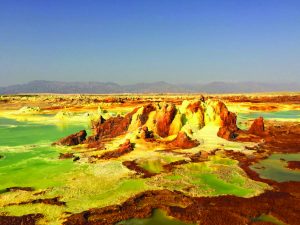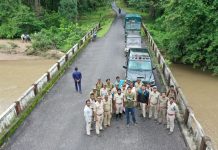 Scientists scanning the universe see the possible presence of liquid water on a world as a clue that there may be conditions friendly to life. But the infernal landscape of the Dallol geothermal field in Ethiopia’s Danakil Depression tells a different story. It says water may not be enough.
Scientists scanning the universe see the possible presence of liquid water on a world as a clue that there may be conditions friendly to life. But the infernal landscape of the Dallol geothermal field in Ethiopia’s Danakil Depression tells a different story. It says water may not be enough.
Researchers have found an aquatic environment on the Earth with complete absence of any forms of life, an advance that may lead to an improved understanding of the limits of habitability. The study, published in the journal Nature Ecology and Evolution, revealed that any form of microbial life was absent in the hot, saline, hyper acid ponds of the Dallol geothermal field in Ethiopia.
The researchers, including those from the Spanish Foundation for Science and Technology (FECYT), said Dallol’s landscape extends over a volcanic crater full of salt, constantly releasing toxic gases with water boiling in the midst of the intense hydro thermal activity. They said it is one of the most torrid environments on the planet with daily temperatures in winter exceeding 45 degrees Celsius.
The landscape, the researchers said, had abundant hyper saline and hyper acid pools, with pH — which is measured on a scale from 0 (very acidic) to 14 (very alkaline) — even hitting the negative mark. Earlier studies had pointed that certain microorganisms can develop in this multi-extreme environment and researchers presented the place as an example of the limits of conditions that can support life.
The researchers said the place was even proposed as a terrestrial analogue of early Mars. “After analyzing many more samples than in previous works, with adequate controls so as not to contaminate them and a well-calibrated methodology, we have verified that there’s no microbial life in these salty, hot and hyper acid pools or in the adjacent magnesium-rich brine lakes,” said study co-author Purificacion Lopez Garcia from FECYT.
The researchers found great diversity of a type of primitive salt-loving microorganisms in the desert, and the saline canyons around the hydro thermal site but not in the hyper acid and hyper saline pools, nor in the Black and Yellow lakes of Dallol which are rich in magnesium.
“And all this despite the fact that microbial dispersion in this area, due to the wind and to human visitors, is intense,” Lopez Garcia said.
The hot, salty, hyperacid pools contain no microbial life at all, according to a French-Spanish team of researchers who published an article in Nature Ecology and Evolution.
Dallol extends over a volcanic crater full of salt, where toxic gases are emitted and water boils amid intense hydrothermal activity, the Spanish Foundation for Science and Technology said in a statement. Daily temperatures in winter can exceed 113 degrees, and the pools can be so acidic they have a negative pH value.
The new study contradicts another study published earlier this year that suggested there was some life in the dead zones. But researchers in the new study said their methods were better.
“After analysing many more samples than in previous works, with adequate controls so as not to contaminate them and a well-calibrated methodology, we have verified that there’s no microbial life in these salty, hot and hyperacid pools or in the adjacent magnesium-rich brine lakes,” biologist Purificación Lopez Garcia of the French National Centre for Scientific Research said in the statement.
“What does exist is a great diversity of halophilic archaea (a type of primitive salt-loving microorganisms) in the desert and the saline canyons around the hydrothermal site,” the biologist said, “but neither in the hyperacid and hypersaline pools themselves, nor in the so-called Black and Yellow lakes of Dallol, where magnesium abounds. And all this despite the fact that microbial dispersion in this area, due to the wind and to human visitors, is intense.”
“Our study presents evidence that there are places on the Earth’s surface, such as the Dallol pools, which are sterile even though they contain liquid water,” she said.
Prior studies said that specific microorganisms can form in this multi-extraordinary environment condition and scientists introduced the spot as an instance of limits of conditions that are able to bolster life. The scientists said the spot was even proposed as an earthly analogue of early Mars.
The scientists found an assorted variety of salt loving microorganisms in the desert, and the saline gulches around the hydrothermal site however not in the hyperacid and hypersaline pools, nor at rich in magnesium black and Yellow pools of Dallol.
The specialists affirmed the discoveries with a few different techniques including an enormous scale sequencing of genetic markers to recognize and classify microorganisms, microbial culture endeavors, utilizing fluorescent probes to distinguish singular cells, substance investigation of the hypersaline waters.
They likewise utilized scanning electron microscopy and X-ray spectroscopy to get into the water samples looking for signs of life. As per researchers, the study helps in understanding the limits of habitability and also helps in presenting evidence that there are places on the surface of the Earth that are sterile, even though they contain liquid water. They also mentioned that the presence of liquid water on a planet does not directly imply the presence of life.
A salt volcano
Dallol looks like a salt volcano with intense degassing and hydrothermal activity on top. Lying on the Danakil depression along the East African Rift, the whole region undergoes intense tectonic, seismic and volcanic activity, being one of the hottest places on Earth (daily winter temperatures can easily exceed 45°C!). Dallol and its surroundings display unique combinations of physicochemical parameters, from hypersaline sites (cave reservoirs in the Dallol west salt canyons, southern Lake Assale), to the acidic hypersaline magnesium-rich brines (Black and Yellow lakes south to the dome) and the hypersaline, hyperacidic (down to negative pH!) and hot pools on Dallol’s dome. Although halophilic, acidophilic and hyperthermophilic microorganisms are well known, do microorganisms exist that are adapted simultaneously to several of those extreme conditions? This is the million-dollar question, answer for which scientists are looking for.
letters@tehelka.com












